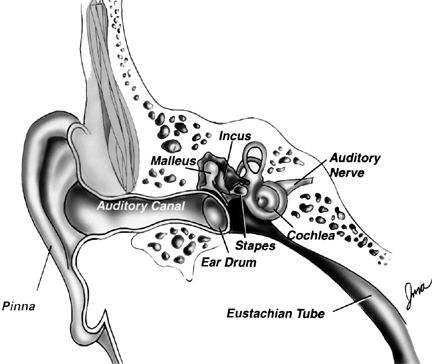Hearing Things? New Study Might Explain Why

Shhh! Did you hear that? The ghostly whispers that grab your attention could be the result of chit-chatting nerve cells in your ears that were there in the womb.
The finding, reported in the Nov. 1 issue of the journal Nature, has implications for treating a phenomenon called tinnitus in which people hear annoying high-pitched sounds with no apparent source.
While the study involved rats, the scientists say the results likely apply to humans who are equipped with similar ear structures.
Silent spectators?
Once a person's (or other mammal's) auditory machinery is fully developed, it works something like this: Sound waves travel through the ear canal and get detected by hair cells in the cochlea. This snail-shaped organ translates the sound signals into electrical impulses that travel along the auditory nerve into the brain's hearing region.
Dwight Bergles, a neuroscientist at Johns Hopkins University in Baltimore, and his colleagues examined how hearing works in young rats whose cochleae were not yet fully developed. Even without mature auditory machinery, the rats showed nerve activity in the brain regions associated with hearing.
The activity showed up even without sound input.
Get the world’s most fascinating discoveries delivered straight to your inbox.
Further lab tests revealed non-sensory hair cells called support cells could explain how the rats could hear without the needed equipment and even without sound input. These support cells reside in the cochlea and had been thought of as silent spectators, uninvolved in nerve communication. However, they showed strong electrical activity in the rats' ears during the study.
The team found evidence that the "bystanders" spontaneously release ATP, the energy molecule of cells, which triggers a cascade of events that lead to electrical impulses being sent to the brain—no sound input needed.
“It is as if ATP substitutes for sound when the ear is still immature and physically incapable of detecting sound,” Bergles said. "The cells we have been studying seem to be warming up the machinery that will later be used to transmit sound signals to the brain.”
Premature hearing
Other mammals, including humans, also have support cells in their ears, so the rat findings could have implications for people as well, the scientists say.
For instance, the finding suggests these support cells in the developing human ear make their own noise long before babies are born and before they can even detect sound. Bergles speculates the premature hearing ability could prep the auditory system for when it goes "live."
The ability to hear subtle sound differences, such as the inflection in a person's voice, “requires a lot of fine-tuning based on where in the brain the nerves connect," Bergles explained. "It could be that brief bursts of electrical activity in just a few nerve cells at a time help do that fine-tuning so the system works well.”
Sound off
By the time rats developed mature ears and could hear sound, the spontaneous ATP-release ceased. That way the sideshow wouldn't interfere with detection of actual sounds, Bergles suggests.
The ear's hair cells held onto their ability to respond to ATP, however, even though none was around. Bergles suspects if a malfunction leads to anomalous release of ATP in people, the support cells might whip into action, making one think they are hearing something—as is the case with tinnitus.
"If ATP were released by the remaining support cells, it may cause the sensation of sound when there is none,” Bergles said.
- Video: How Sound Waves Travel Through the Ear
- Top 10 Things You Didn't Know About You
- Body Quiz: What the Parts Do
Jeanna Bryner is managing editor of Scientific American. Previously she was editor in chief of Live Science and, prior to that, an editor at Scholastic's Science World magazine. Bryner has an English degree from Salisbury University, a master's degree in biogeochemistry and environmental sciences from the University of Maryland and a graduate science journalism degree from New York University. She has worked as a biologist in Florida, where she monitored wetlands and did field surveys for endangered species, including the gorgeous Florida Scrub Jay. She also received an ocean sciences journalism fellowship from the Woods Hole Oceanographic Institution. She is a firm believer that science is for everyone and that just about everything can be viewed through the lens of science.


